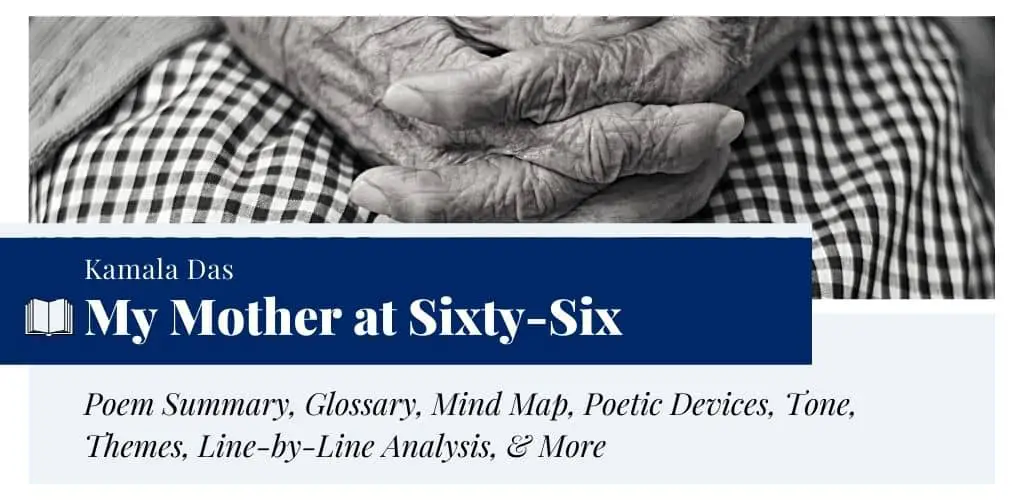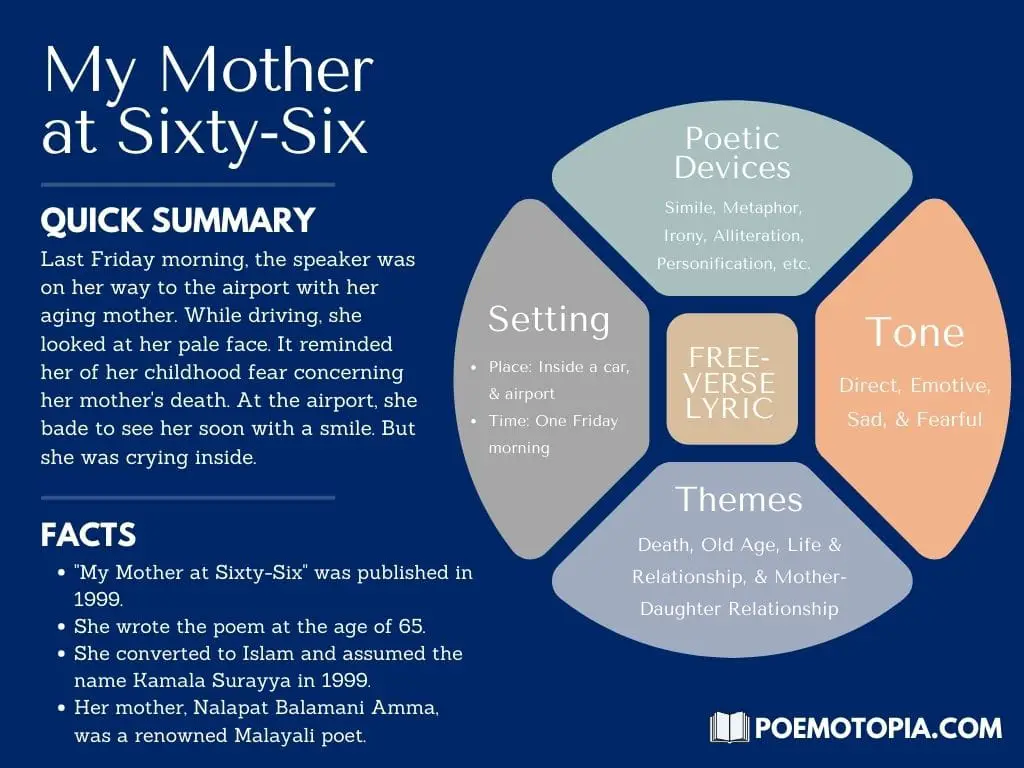My Mother at Sixty-Six Summary, Poetic Devices, & Analysis
“My Mother at Sixty-Six” is a lyric poem written by Kamala Das. She is one of the greatest feminist poets of India. She deliberately shed off the age-old customs and conventions of society through her poetry. Her poetry voiced her stance in a clear and straightforward manner. Readers can understand how strong her voice is if they immersed themselves in My Story: a semi-autobiography of Das or her signature poem, “An Introduction.”
Kamala Das’ poems always have an appealing voice that lingers in the mind of readers. What is in her heart, she says it directly without any exaggeration. Her directness of speech is also visible in her poem “My Mother at Sixty-Six.” The way she deals with such a critical topic is commendable. Especially, the speaker’s “smile” depicted in the last few lines of this poem says much more than words convey.
Why does her speaker smile at the end, or why does Das use ellipsis there? To know the answers dive deeper into the analysis.
- Read the full text of “My Mother at Sixty-Six” below:
My Mother at Sixty-Six by Kamala Das Driving from my parent’s home to Cochin last Friday morning, I saw my mother, beside me, doze, open mouthed, her face ashen like that of a corpse and realised with pain that she was as old as she looked but soon put that thought away, and looked out at Young Trees sprinting, the merry children spilling out of their homes, but after the airport’s security check, standing a few yards away, I looked again at her, wan, pale as a late winter’s moon and felt that old familiar ache, my childhood’s fear, but all I said was, see you soon, Amma, all I did was smile and smile and smile...... - from Selected Poems (2014)

Glossary
Let’s have a look at some important words and their meanings in the text.
- Cochin: Cochin or Kochi is a city in Kerala (Line 2: “home to Cochin last Friday”)
- Doze: to sleep lightly, nap (Line 5: “doze, open-mouthed, her face”)
- Ashen: very pale or colorless, resembling the color of ashes (Line 6: “ashen like that”)
- Corpse: a dead body (Line 7: “of a corpse and realised with pain”)
- Sprinting: running (Line 12: “Trees sprinting, the merry children spilling”)
- Spilling out: overflowing (Line 12 & 13: “the merry children spilling/ out of their homes …”)
- Wan: pale, ashen (Line 15: “away, I looked again at her, wan, pale”)
- Ache: pain (Line 17: “familiar ache, my childhood’s fear”)
A Mind Map

Summary
“My Mother at Sixty-Six” begins in a story-like manner. Once, the poetic persona or the poet herself headed towards Cochin to catch the flight. The place is also known as Kochi, situated in Kerala. While she was on the way, driving the car, she suddenly looked at her mother’s face. The old lady was sleepy, and she was dozing open-mouthed. Her face resembled that of any aged person. The speaker could see some signs of pain on her face. It is natural; her only daughter was leaving her behind.
Putting off the thoughts of her mother, she looked outside the car. The “young trees” rapidly going behind (for the speed of her car) grabbed her attention. Children “spilled” out of their homes happily to play. After that, the poet quickly shifts to the airport’s security checking scene. She stood a few yards away from her mother and looked at her pale face. A chilling sensation of fear concerning her mother’s imminent death made her numb. Nothing crossed her mind, instead of the thought of her mother’s death. She struggled to utter a customary goodbye to her amma. Then she put on a mask of a smile and left.
Meaning of the Title
The title, “My Mother at Sixty-Six,” introduces the main idea. It is about the poet’s sixty-six-year-old mother. When she left Cochin, her mother was of that age, and her face reflected the signs of imminent death. However, Das does not merely point at her mother’s age but also writes about her physical condition during that time. Through this poem, Das reflects on the approaching death of her aging mother.
Instead of crying, she accepts reality and puts up a smile on her face. Though her heart aches to think about the fact, her mind knows that she cannot alter the inevitable. A smile is enough to alleviate the aching soul. Nobody can change reality. So it is crucial to learn the art of accepting things and keep moving. Our thoughts keep us chained to the saddening thoughts. When we release ourselves from the shackles of relationships, our mind becomes free; whether it was the case with the speaker is a matter of introspection.
Form, Rhyme Scheme, & Meter
Form
Das’s “My Mother at Sixty-Six” consists of 20 lines having uneven line lengths. It is a lyric poem as the poem is written from the first-person point of view. The poet directly introduces herself by using the pronoun “I”. She talks about an incident in her life. What she thought on that day while leaving her old mother behind is described in this poem.
If readers closely analyze the poem, they can find the absence of full stops or end-stopped lines. It infers that it is written in the form of a single chain of thoughts, also known as a “stream-of-consciousness.” When people think about something deeply, they visualize the things in an unbroken flow. Das’s speaker also thought similarly about her mother’s face while she left her mother at the airport. She shares what thoughts appeared in her mind. That’s why the poet does not use any full stop to break her thought process in the middle. It is called the stream-of-consciousness technique. This form concerns an unending stream of thoughts that flows ceaselessly in one’s mind.
Rhyme Scheme
“My Mother at Sixty-Six” is written in free verse. It means the text does not contain a regular rhyme scheme. Das uses internal rhyming and short lines to maintain the flow of the poem. Besides, the repetition of similar sounds also helps the poet create internal rhyming. The poem sounds like everyday speech or spoken-word poetry in the absence of conventional rhyming.
Meter
The overall poem is primarily written in a combination of the iambic-trochaic meter. The use of falling rhyme depicts a sense of grief. In this poem, the sound scheme in each line rises and falls like the breathing pattern of a depressed person. Das’s persona displays her pain of losing her mother. Through the metrical composition, she suggests this feeling.
A trochee contains a stressed syllable followed by an unstressed syllable (For example, “Dri-ving”, “home to,” etc.). In contrast, an iambic foot has an unstressed syllable followed by a stressed syllable (For example: “I saw/ my moth(e)r“). The metrical scheme depicts the speaker’s sadness. Alongside that, the falling rhythm and the word choice help readers to understand her changing mental state across the text.
Poetic Devices & Figures of Speech
In “My Mother at Sixty-Six,” there are several poetic devices. Those devices make the poet’s thoughts more appealing to readers. Let’s explore the poetic devices used in the poem.
Enjambment
One of the most important poetic devices used in this poem is enjambment. Das does not use any full stop marks throughout the text, even at the end. There is an ellipsis (…) at the end of the last line. The poet enjambs the lines to create a chain of thoughts. Each line proceeds to the following one to complete the idea, continuing until the end. The whole idea becomes clear after going through a few lines. For example, the context becomes clear after reading the first four lines:
Driving from my parent’s
home to Cochin last Friday
morning, I saw my mother,
beside me,
Then readers have to go through the succeeding lines (5-10) in order to know what the speaker felt after glancing back at her mother from the car seat.
doze, open mouthed, her face
ashen like that
of a corpse and realised with pain
that she was as old as she
looked but soon
put that thought away, and
Alliteration
It occurs in the phrase “my mother” in the very title. The “m” sound gets repeated at the beginning of these words. As the consonant sound is repeated, it is also an example of consonance. It can also be found in the phrase, “Sixty-Six” (Here, the “i” sound also gets repeated; an example of assonance as well). Now, let’s have a look at some specific examples of consonance and assonance from the text.
Consonance
- “I saw my mother,/ beside me,”
- “face/ ashen” (listen to the repetition of the soft “s” sound; it’s called sibilance)
- “she was as old as she/ looked but soon” (another instance of sibilance)
- “Young/ Trees sprinting”
- “but all I said was, see you soon, Amma,/ all I did was smile and smile and/ smile……” (Now ask yourself, why does the poet use the “s” sound so frequently? It’s because the sound not only has a soothing effect but it also resonates with the sad mental state of the speaker)
Assonance
- “home to Cochin” (Remember: the “o” at the end of “to” isn’t pronounced as the “o” in “home.” It sounds like an unstressed “ah,” called schwa.)
- “doze, open”
- “ashen like that”
- “looked but soon”
- “Trees sprinting, the merry children spilling” (Listen to the uplifting effect of the long “i” sound; have you noticed there is also a consonance in “sprinting” and “spilling.” How beautifully Kamala Das wove this piece!)
- “pale/ as a late”
Simile
- It occurs in the lines, “her face/ ashen like that/ of a corpse.” The poet explicitly compares the color of her mother’s face to that of a corpse. The pale old face of her mother also makes the poet think about her impending death. She visualizes the image of funeral ashes while staring at her aging mother.
- In “that she was as old as she/ looked,” the speaker compares the physical features of her mother to the external signs of aging by using the linker “as.”
- In “I looked again at her, wan, pale/ as a late winter’s moon,” the speaker compares her mother’s light-colored face to a “late winter’s moon.” She uses the image of the moon to depict the similarities between the color of her aging mother’s face and that of the moon in late winter, which looks light white from the earth due to the dense cold air.
Personification
It occurs in “Young/ Trees sprinting.” The poet capitalizes the first letters of these words, “Young” and “Trees.” She does so by personifying the trees with the idea of being young and sprinting. The phrase also contains a personal metaphor, “Young.” This adjective is also used to compare the trees with young kids.
Metaphor
- There is an interesting metaphor in the line, “the merry children spilling/ out of their homes.” The energy and spontaneity of children are compared to a glass full of liquid. The glass or the container is their home, and the kids are the essence that fills their home with laughter and joy. By looking at the kids, it seems they are spilling out their energy while coming out of their homes to play.
- The phrase “late winter’s moon” contains a metaphor too. Through this phrase, the poet portrays the pale-white color of the moon during winter’s end. It is comparable to the face of an aged person.
Metonymy
- The phrase “merry children” is a metonym/symbol of innocence, freshness, liveliness, and hope. The variety used here is a symbol for the thing symbolized.
- We can find a similar use of metonymy in the phrase “late winter’s moon.” It is a metonym for death and old age.
Tautology
It occurs in “away, I looked again at her, wan, pale.” “Wan” and “pale” both have the same meanings. When a writer repeats words having a similar meaning, it is called tautology in rhetorics.
Palilogy and Polysyndeton
In the last lines, “all I did was smile and smile and/ smile …” readers can find two literary devices. Firstly, the conjunction “and” is used twice for the sake of emphasis. It is called polysyndeton. Secondly, the same word “smile” is repeated thrice. It is called a palilogy. These two poetic devices are grouped as figures based on construction.
Line-by-Line Critical Analysis & Explanation
Lines 1-7
Driving from my parent’s
home to Cochin last Friday
morning, I saw my mother,
beside me,
doze, open mouthed, her face
ashen like that
of a corpse and realised with pain
In the first few lines of the poem “My Mother at Sixty-Six,” Kamala Das depicts a speaker and her mother sitting in a car and heading towards the Cochin airport. While the speaker (or the poet) was on the way, she looked at her old mother dozing in her seat. From the second line, it is clear that the speaker is recapitulating the scene after some days of leaving her mother. The scene constitutes some flicks of that day. In this poem, she reflects on the departure and, most notably, on her aging mother.
From the description of her mother, we can infer that she was not physically well, as drowsiness is a common symptom in older adults. The poet hints at her mother’s imminent death in the line, “her face/ ashen like that/ of a corpse.” The epithet “ashen” hints at this idea.
Old age is a critical juncture in one’s life. It is the same for the people around that person. The body starts to deteriorate at this stage, and the mind weakens. The face reflects the age-worn pain borne by the heart. There sparks a pain in her heart seeing her mother’s “ashen” face. Readers can easily sense this pain in the upcoming lines.
Lines 8-13
that she was as old as she
looked but soon
put that thought away, and
looked out at Young
Trees sprinting, the merry children spilling
out of their homes, but after the airport’s
The condition of the speaker’s mother makes readers pity her. She is well aware of reality. Still, there is an unknown fear in her heart. The age of “sixty-six” is a critical moment in any person’s life, especially that of a woman. Exceptions are always there, but the poet’s mother is drooping with age’s burden. In this section, the poet discloses that she was as old as she looked. These lines are a bit tricky. The poet might have meant that the lady mentally accepted her age. Here, she introduces the paradox of aging through her words. “We become what we think.”
In the following lines, the image of the old mother is in stark contrast with the imagery of the “Young Trees” and “merry children.” Collectively, these images create a contrast between life and death, hope and hopelessness. Inside the car, her aging mother gave her feelings of grief and hopelessness. In contrast, the outside scene from the car filled the speaker with hope, joy, and vitality.
If readers look outside of the car along with the speaker, they can see green trees full of vitality rushing behind, energetic children running out of their houses to play, and the freshness of morning air (which the speaker does not state explicitly). In this way, the cloud of despair disappears in the last lines of this section. However, the overall poem is written in a despairing and depressing tone. Those images act as soft rays of the blushing sun hiding behind the monsoon clouds.
Lines 14-20
security check, standing a few yards
away, I looked again at her, wan, pale
as a late winter’s moon and felt that old
familiar ache, my childhood’s fear,
but all I said was, see you soon, Amma,
all I did was smile and smile and
smile……
Das quickly shifts to reality again. Her persona recalls the moment when she stood at the airport’s security check and her mother was a few yards away. She looked back at her pale face, and it seemed to her as the “late winter’s moon.” Winter is a season of harsh weather conditions, lack of life, and full of hopelessness. Hence it is used as a metaphor for one’s approaching death. In this phrase, the moon is used to symbolize the color of her mother’s face.
In the following line, the poetic persona hints at her “childhood’s fear.” She refers to the fear of her mother’s approaching death in a roundabout manner. It is an example of insinuation, a poetic device. As a child, she might have thought that someday her mother was going to leave her alone. She cannot protect her loved ones from dying. At the time of leaving her mother, she was reminded of this truth, the mortality of her mother.
At the moment of leaving, several thoughts were running through her mind. But, she could say nothing more. She was not sure whether she could see her again or not. All she had was hope, realization, and a frail determination to lead her life on her own. Finally, she left with a smile on her face. The smile does not emerge from the best memories she had with her mother. It is signaling her hidden despair. She knows every mortal being is destined to die. This awareness made her numb, and she could not utter anything, even a hearty, warm goodbye.
How could she say anything more apart from smiling back at her mother, probably bidding the final farewell?
Themes
Death
Death or mortality is one of the most significant themes of “My Mother at Sixty-Six.” Kamala Das depicts the theme by using the image of the aging mother and especially her “ashen” face. In the first encounter, the speaker’s mother is seen dozing open-mouthed. The complexion of her face resembles that of a deceased person. Next, the speaker stands in the airport. This time, she uses “wan” and “pale” to describe her mother’s face. These adjectives are closely associated with a dying person. In this way, the theme of death or mortality lingers throughout the poem.
Old Age
The poet illustrates the immobility and stiffness of old age through the image of her sixty-six-year-old mother. She describes how old age makes a person weak and fragile with time. Her pale face is a representation of hopelessness as well as death. Though it is not clear whether she is suffering from any ailment or not, the poet’s choice of words reveals that she is not well. In this way, the poet makes use of the theme of old age through the pessimistic image of her mother.
Life versus Death
Apart from the themes of death and old age, there is also the theme of life versus death and hope versus pessimism. Das only uses two images to tap on this theme. One is of the “Young Trees” sprinting alongside the car. The other one is of the “merry children spilling out of their homes.” The trees symbolize life and mobility, and the children symbolize innocence and vitality. In contrast, the image of her mother’s face portrays the futility of life, hopelessness, and despair. In this way, the children running out of their homes depict the bright side of life.
The poet takes us to her inner world. She shares her intimate thoughts and makes readers her compatriot of the pain she felt on that day. She is aware of the fact that she has to leave her aging mother behind at some point. It is true that the process is painful and takes a lot of effort to forget one’s loved ones. But it’s life. Moving on with the freshness of the morning, leaving the ashes of the past behind, is part and parcel of life.
Mother-Daughter Relationship
Kamala Das also presents the theme of the mother-daughter relationship in “My Mother at Sixty-Six.” This poem contains a daughter’s feelings for her aging mother, standing on the verge of death. The pale face of her old mother pains her deep. She feels stranded in this journey of life whenever the thought of her mother’s death crosses her mind. At the moment of departure, when she looked at her mother, she was speechless to think that she was going to die one day. She could not say anything instead of smiling by hiding her tears: all I said was, see you soon, Amma,/ all I did was smile and smile and/ smile……”
Tone & Mood
The first few lines of Kamala Das’s “My Mother at Sixty-Six” are written using a sad and depressing tone. The speaker talks about her aging mother in a natural tone. Though she is sympathetic towards her mother, she talks about her face realistically. It sounds like she is talking about any aged person next door. She says that there is an “ashen” look on her face. This word hints at her mother’s approaching death. While talking about these things, her tone is straightforward.
In lines 11-13, she describes how nature is filled with life, hope, and vitality. Momentarily, her tone becomes a bit uplifting and hopeful. However, it changes in the lines after. It resonates with the tone of the first section and continues throughout the text. Towards the end, the speaker hints at her childhood fear of losing her mother. These lines reflect the pain of losing her mother.
Historical Context
“My Mother at Sixty-Six” by Kamala Das was published in 1999. In the same year, Kamala Das converted to Islam. She was 65 years old then. In this poem, Das recalls the memory of her mother. Her mother, Balamani Amma, was also a writer. Kamala followed her mother’s path and excelled in the field.
In this poem, Das depicts the scene of leaving her mother at the airport. The event probably happened after her marriage. She was married at the early age of 15. While leaving her mother, several thoughts appeared in her mind. But, without saying anything to her mother, she left with a smile.
Ironically, she recalls the memory at the age of 65, a year before turning 66. She might have been thinking about what her mother would have thought or how she felt on that day. It made her emotional, and she penned down this lyric. While writing, a similar sense of mortality was vivid in her mind as she would turn sixty-six.
Questions and Answers
The irony of “My Mother at Sixty-Six” is that the speaker did not actually smile while leaving her mother at the airport. Though she would have smiled, apparently, she was sobbing inside her mind.
Kamala Das reveals the irony of human relationships by portraying how she left her mother at the airport. She knew that her mother was going to die soon. Still, she had to leave her alone.
The message of this piece lies in the attitude of the speaker towards her mother. Her departure signifies that everyone has to leave their loved ones someday.
The phrase “smile and smile and smile” contains three poetic devices: repetition, tautology, and polysyndeton.
Kamala Das’s childhood fear was the imminent death of her mother. She hid her fear behind the facade of a smile.
To put away the thoughts of her aging mother, she looked outside the car and tried to rejuvenate her thoughts with the vitality of nature.
The children are depicted as a symbol of life and energy. It seemed to the poet that the children were spilling out their energy while coming out of their homes to play.
To put away the thoughts of her aging mother, she looked outside the car and tried to rejuvenate her thoughts with the vitality of nature.
The poet smiled to hide her pain. She did not want to show her true feelings to her mother as it would make her mother weak. In the end, she could only say, “see you soon, Amma.”
Her mother’s face was ashen due to aging. The poet compares her mother’s face to a corpse to foreshadow her imminent death and mortality.
Similar Poems about Relationships
- “Fear” by Gabriela Mistral — In this poem, a speaker expresses her fear of losing her daughter when she grows up.
- “The Writer” by Richard Wilbur — This poem is about a father’s concern for his daughter.
- “Death of a Young Son by Drowning” by Margaret Atwood — This poem captures a mother’s reaction to the event of her only son’s death.
- “Eating Together” by Li-Young Lee — In this poem, the speaker misses his deceased father at the family lunch.
External Resources
- Check out My Story: A Semi-autobiography of Kamala Das — Explore one of the best-selling woman’s autobiographies in India, My Story, a realist and fictional amalgamation of poet Kamala Das’ life.
- About Kamala Das — Read about the poet’s inspirational biography and her works.
- Facts about Kamala Das — Learn more about the poet’s life and some interesting facts about her life.
- Kamala Das: The Ignited Soul — Learn how Kamala Das was radical in her thoughts and how she chose to lead her life as a feminist.
- Celebrating Kamala Das — Watch this Google Doodle portraying one of the greatest feminist poets of India, Kamala Das.
- Best 20th Century Indian Poets — Read how R. Parthasarathy evaluates the poet.







This was excellent and so well-explained! Thank you so very much!
We’re more than happy to help! Please rate the analysis if you wish. Let us know the names of some poems that you want us to analyze.
Everything is amazingly explained and providing a mind map too is just a cherry on top! thanks a lot